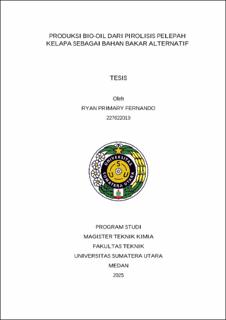Produksi Bio-oil dari Hasil Pirolisis Pelepah Kelapa sebagai Bahan Bakar Alternatif
Bio-oil Production from Pyrolisis of Coconut Fronds as Alternative Fuels

Date
2025Author
Fernando, Ryan Primary
Advisor(s)
Sarah, Maya
Hasibuan, Rosdanelli
Metadata
Show full item recordAbstract
Energy is an important issue that needs to be addressed in Indonesia. The rapid economic growth and increasing population indirectly have a significant impact on energy consumption. The utilization of biomass has become one of the alternative solutions for generating renewable energy. One type of biomass that can be used as a renewable energy source are the coconut fronds, which contains cellulose (39.05%), hemicellulose (22.49%), and lignin (21.46%). The conversion of coconut fronds into energy can be carried out through pyrolysis, which produces bio-char, bio-oil, and non-condensable gases. This study aims to: (1) analyze the composition of bio-oil produced from the pyrolysis of coconut fronds at various pyrolysis temperatures and time; and (2) evaluate the effect of pyrolysis temperature and time on the characteristics of bio-oil from coconut frond pyrolysis as an alternative energy source. The pyrolysis of coconut fronds was conducted at temperatures of 400°C, 450°C, and 500°C with time variations of 60 minutes, 120 minutes, and 180 minutes. The compositional analysis using GC-MS showed that the resulting bio-oil consists of various hydrocarbon compounds. Phenols were the main components (67.04-78.22%), followed by furans (5.30-14.14%), ketones (4.63-11.28%), acids (4.36-6.51%), ethers (1.42%), and other compounds (1.09-5.69%). Increasing the pyrolysis temperature and duration was found to increase the bio-oil yield. The highest bio-oil yield was obtained at a pyrolysis temperature of 500°C for 180 minutes. Under these conditions, the bio-oil had a water content of 20.32%, a density of 1,177.7 kg/m³, a kinematic viscosity of 1.247 cSt, an acid number of 0.583, and a calorific value of 27.204 MJ/kg. The bio-oil produced, particularly at 400°C, 450°C, and 500°C for 180 minutes, closely approached the ASTM D7544 standard, which is the standard for pyrolysis bio-oil.
Collections
- Master Theses [142]
